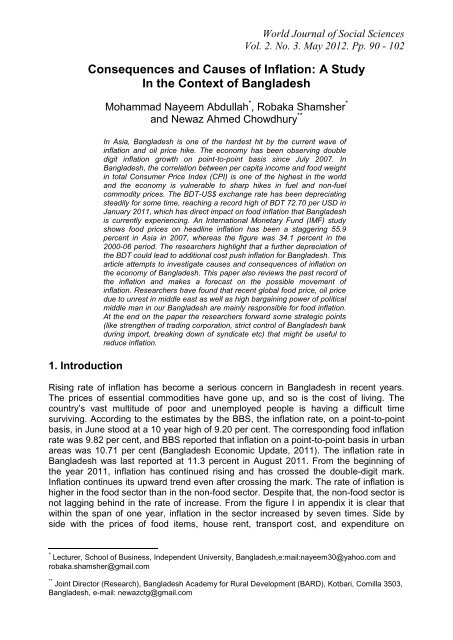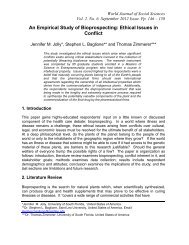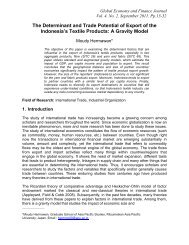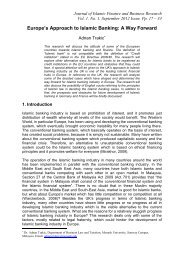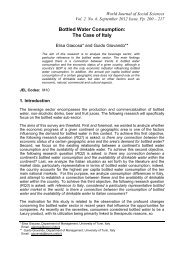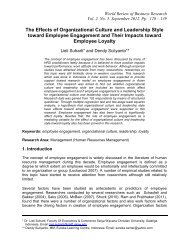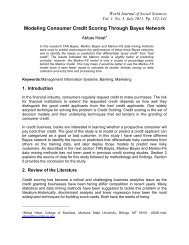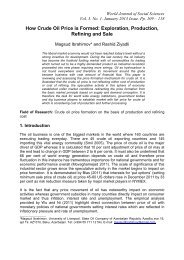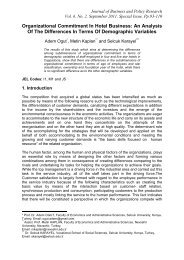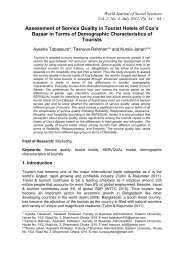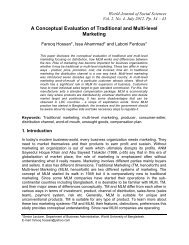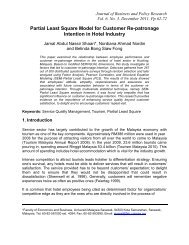Consequences and causes of inflation: A study in the ... - Wbiaus.org
Consequences and causes of inflation: A study in the ... - Wbiaus.org
Consequences and causes of inflation: A study in the ... - Wbiaus.org
You also want an ePaper? Increase the reach of your titles
YUMPU automatically turns print PDFs into web optimized ePapers that Google loves.
Abdullah, Shamsher & Chowdhurycloth<strong>in</strong>g <strong>and</strong> shoes have also <strong>in</strong>creased (Mat<strong>in</strong>, 2011). As a result, <strong>the</strong> people arepass<strong>in</strong>g <strong>the</strong>ir days amid hardship, spend<strong>in</strong>g additional money on a static <strong>in</strong>come.The objective <strong>of</strong> this paper is to generate analysis <strong>and</strong> discussion on some key issues<strong>of</strong> <strong>the</strong> Bangladesh <strong><strong>in</strong>flation</strong>, identify major challenges <strong>and</strong> suggest policyrecommendations. In do<strong>in</strong>g so, selected macroeconomic <strong>in</strong>dicators such as GDPgrowth, external trade, money, food situation, foreign aid, exchange rate, <strong>and</strong>remittance <strong>and</strong> foreign exchange reserve have been critically reviewed. Objectives <strong>of</strong><strong>the</strong> <strong>study</strong> are listed below:1. Summarize <strong>the</strong> <strong><strong>in</strong>flation</strong> scenario <strong>in</strong> Bangladesh.2. Underst<strong>and</strong> <strong>the</strong> <strong>causes</strong> <strong>of</strong> <strong><strong>in</strong>flation</strong> <strong>in</strong> <strong>the</strong> Bangladesh Economy.3. Underst<strong>and</strong> <strong>the</strong> consequences <strong>of</strong> <strong><strong>in</strong>flation</strong> <strong>in</strong> <strong>the</strong> Bangladesh Economy.4. To f<strong>in</strong>d applicable strategies to cope with Inflation <strong>in</strong> Bangladesh.To conduct this <strong>study</strong> <strong>the</strong> researchers have not followed any ma<strong>the</strong>matical model tocheck relation between <strong><strong>in</strong>flation</strong> <strong>and</strong> long run economic <strong>in</strong>dicators. The rationale beh<strong>in</strong>dthis <strong>study</strong> is to focus on recent <strong>causes</strong> <strong>of</strong> <strong><strong>in</strong>flation</strong> <strong>in</strong> light <strong>of</strong> <strong>the</strong> global crises <strong>and</strong> try t<strong>of</strong><strong>in</strong>d out <strong>the</strong> consequences <strong>and</strong> applicable strategies to overcome it. Previous f<strong>in</strong>d<strong>in</strong>gs <strong>in</strong>develop<strong>in</strong>g countries tried to f<strong>in</strong>d out <strong>the</strong> relationship between <strong><strong>in</strong>flation</strong> <strong>and</strong> o<strong>the</strong>r macroeconomic factors with <strong>the</strong> basis <strong>of</strong> complex ma<strong>the</strong>matical models. Our paper tries t<strong>of</strong>ocus on some basic <strong>causes</strong> <strong>and</strong> consequences related to <strong><strong>in</strong>flation</strong> that might helpgovernment f<strong>in</strong>d out possible strategies encounter that. We focus on role <strong>of</strong> import<strong>in</strong>g bygovernment, recent food production scenario, oil prices <strong>and</strong> crisis <strong>in</strong> Middle East due toArab spr<strong>in</strong>g as well as role <strong>of</strong> syndication. Even though it is simple ra<strong>the</strong>r thanemphasiz<strong>in</strong>g on complex model, we hope it will draw a holistic picture <strong>of</strong> <strong><strong>in</strong>flation</strong> <strong>in</strong>Bangladesh.Section 2 <strong>of</strong> this paper summarized <strong>the</strong> previous studies <strong>and</strong> it provides a hypo<strong>the</strong>sis.Section 3 provides an idea about methodology <strong>of</strong> <strong>the</strong> <strong>study</strong>, section 4.1 provides a briefidea about <strong><strong>in</strong>flation</strong> scenario <strong>in</strong> Bangladesh, 4.2 explores <strong>the</strong> <strong>causes</strong> <strong>of</strong> <strong><strong>in</strong>flation</strong> <strong>and</strong> 4.3expla<strong>in</strong> <strong>the</strong> consequences on <strong>the</strong> economy, lastly section 5 expla<strong>in</strong>s possiblerecommendation with strategies as well as conclusion.2. Literature ReviewThe relationship between <strong><strong>in</strong>flation</strong> <strong>and</strong> growth rema<strong>in</strong>s a controversial one <strong>in</strong> both<strong>the</strong>ory <strong>and</strong> empirical f<strong>in</strong>d<strong>in</strong>gs. Orig<strong>in</strong>at<strong>in</strong>g <strong>in</strong> <strong>the</strong> Lat<strong>in</strong> American context <strong>in</strong> <strong>the</strong> 1950s, <strong>the</strong>issue has generated an endur<strong>in</strong>g debate between structuralists <strong>and</strong> monetarists. Thestructuralists believe that <strong><strong>in</strong>flation</strong> is essential for economic growth, whereas <strong>the</strong>monetarists see <strong><strong>in</strong>flation</strong> as detrimental to economic progress. There are two aspects tothis debate: (a) <strong>the</strong> nature <strong>of</strong> <strong>the</strong> relationship if one exists <strong>and</strong> (b) <strong>the</strong> direction <strong>of</strong>causality. Friedman (1973) succ<strong>in</strong>ctly summarized <strong>the</strong> <strong>in</strong>conclusive nature <strong>of</strong> <strong>the</strong>relationship between <strong><strong>in</strong>flation</strong> <strong>and</strong> economic growth as follows:“Historically, all possible comb<strong>in</strong>ations have occurred: <strong><strong>in</strong>flation</strong> with <strong>and</strong> withoutdevelopment, no <strong><strong>in</strong>flation</strong> with <strong>and</strong> without development”.Earlier work (Tun Wai, 1959) failed to establish any mean<strong>in</strong>gful relationship between<strong><strong>in</strong>flation</strong> <strong>and</strong> economic growth. A more recent work by Paul, Kearney <strong>and</strong> Chowdhury91
Abdullah, Shamsher & Chowdhury(1997) <strong>in</strong>volv<strong>in</strong>g 70 countries (<strong>of</strong> which 48 are develop<strong>in</strong>g economies) for <strong>the</strong> period1960-1989 found no causal relationship between <strong><strong>in</strong>flation</strong> <strong>and</strong> economic growth <strong>in</strong> 40per cent <strong>of</strong> <strong>the</strong> countries; <strong>the</strong>y reported bidirectional causality <strong>in</strong> about 20 per cent <strong>of</strong>countries <strong>and</strong> a unidirectional (ei<strong>the</strong>r <strong><strong>in</strong>flation</strong> to growth or vice versa) relationship <strong>in</strong> <strong>the</strong>rest. More <strong>in</strong>terest<strong>in</strong>gly, <strong>the</strong> relationship was found to be positive <strong>in</strong> some cases, butnegative <strong>in</strong> o<strong>the</strong>rs. Recent cross-country studies <strong>of</strong> Fischer (1993), Barro (1996) <strong>and</strong>Bruno <strong>and</strong> Easterly (1998) show that <strong><strong>in</strong>flation</strong> affect<strong>in</strong>g economic growth negatively<strong>in</strong>clude. Fischer (1993) <strong>and</strong> Barro (1996) found a very small negative impact <strong>of</strong> <strong><strong>in</strong>flation</strong>on growth. Yet Fischer (1993) concluded “however weak <strong>the</strong> evidence, one strongconclusion can be drawn: <strong><strong>in</strong>flation</strong> is not good for longer-term growth”. Barro (1996) alsopreferred price stability because he believed it to be good for economic growth.Bruno <strong>and</strong> Easterly‟s (1998) work is <strong>in</strong>terest<strong>in</strong>g for not<strong>in</strong>g that <strong>the</strong> ratio <strong>of</strong> people whobelieve <strong><strong>in</strong>flation</strong> is harmful to economic growth to tangible evidence is unusually high.Their <strong>in</strong>vestigation confirms <strong>the</strong> observation <strong>of</strong> Dornbusch (1993), Dornbusch <strong>and</strong>Reynoso (1989), Lev<strong>in</strong>e <strong>and</strong> Renelt (1992) <strong>and</strong> Lev<strong>in</strong>e <strong>and</strong> Zervos (1993) that <strong>the</strong><strong><strong>in</strong>flation</strong>-economic growth relationship is <strong>in</strong>fluenced by countries with extreme values(ei<strong>the</strong>r very high or very low <strong><strong>in</strong>flation</strong>). Thus, Bruno <strong>and</strong> Easterly (1998) exam<strong>in</strong>ed onlycases <strong>of</strong> discrete high-<strong><strong>in</strong>flation</strong> (40 per cent <strong>and</strong> above) crises <strong>and</strong> found a robustempirical result that growth falls sharply dur<strong>in</strong>g high-<strong><strong>in</strong>flation</strong> crises, <strong>the</strong>n recoversrapidly <strong>and</strong> strongly after <strong><strong>in</strong>flation</strong> falls.Although many cross-sectional studies have been carried out to establish <strong>the</strong> exactrelationship between growth <strong>and</strong> <strong><strong>in</strong>flation</strong>, very few studies have been conducted forBangladesh. Malik <strong>and</strong> Chowdhury (2001) exam<strong>in</strong>ed <strong>the</strong> <strong><strong>in</strong>flation</strong>-growth relationship forfour South Asian countries (Bangladesh, India, Pakistan <strong>and</strong> Sri Lanka) for <strong>the</strong> period1974–97. They found a positive relation between <strong><strong>in</strong>flation</strong> <strong>and</strong> growth rates with nostructural break for <strong>the</strong> four countries. On <strong>the</strong> o<strong>the</strong>r h<strong>and</strong>, Burdek<strong>in</strong> et al. (2000), <strong>and</strong>Judson <strong>and</strong> Orphanides (1999) have estimated a non-l<strong>in</strong>ear relationship <strong>and</strong> discoveredstructural breaks for many develop<strong>in</strong>g countries <strong>in</strong>clud<strong>in</strong>g Bangladesh. These variedf<strong>in</strong>d<strong>in</strong>gs, <strong>the</strong>refore, deserve fur<strong>the</strong>r <strong>in</strong>vestigation for policy implications. Besides, it isargued that an <strong>in</strong>dividual country <strong>study</strong> should provide more reliable estimates thancross-country studies as country-specific relevant variables can be controlled properly<strong>and</strong> homogeneity can also be ma<strong>in</strong>ta<strong>in</strong>ed. Different dem<strong>and</strong> <strong>and</strong> supply responses forpolicy changes <strong>in</strong> different countries might result <strong>in</strong> different economic outcomes <strong>and</strong>provide mislead<strong>in</strong>g results under cross-sectional data. Temple (2000) po<strong>in</strong>ted out that <strong>in</strong>cross-country studies compris<strong>in</strong>g relatively dissimilar develop<strong>in</strong>g countries, <strong><strong>in</strong>flation</strong>aryimpacts might differ <strong>and</strong> <strong>the</strong>refore, extrapolation requires more caution. He fur<strong>the</strong>rargued, cit<strong>in</strong>g f<strong>in</strong>d<strong>in</strong>gs <strong>of</strong> several studies that <strong>the</strong> detection <strong>and</strong> significance <strong>of</strong> somerelationships change when cross-section <strong>in</strong>stead <strong>of</strong> annual panel data is used or if <strong>the</strong>time-horizon is altered. Bangladesh is under pressure from <strong>the</strong> <strong>in</strong>ternational lend<strong>in</strong>gagencies (IMF, <strong>the</strong> World Bank <strong>and</strong> ADB) to reduce its <strong><strong>in</strong>flation</strong> rates <strong>in</strong> order to boosteconomic growth.Two recent works (Bruno <strong>and</strong> Easterly, 1998 <strong>and</strong> Paul, Kearney <strong>and</strong> Chowdhury, 1997)do not shed much light on what is <strong>the</strong> right approach. Their f<strong>in</strong>d<strong>in</strong>gs appear counter<strong>in</strong>tuitiveas <strong>the</strong> four South Asian countries share a very similar economic structure <strong>and</strong>until very recently have followed (<strong>and</strong> are still follow<strong>in</strong>g) roughly similar economicpolicies (e.g., a relatively large public sector, a nationalized f<strong>in</strong>ancial sector <strong>and</strong> fiveyearplans though with vary<strong>in</strong>g emphasis). It is possible that <strong>the</strong> counter-<strong>in</strong>tuitive results<strong>of</strong> Paul, Kearney <strong>and</strong> Chowdhury (1997) are due to methodological deficiencies. Forexample, Paul, Kearney <strong>and</strong> Chowdhury (1997) used <strong>the</strong> Dickey-Fuller (DF) <strong>and</strong>92
Abdullah, Shamsher & Chowdhuryaugmented Dickey-Fuller (ADF) tests. The ADF tests are unable to differentiate wellbetween non-stationary <strong>and</strong> stationary series with a high degree <strong>of</strong> autocorrelation(West, 1988) <strong>and</strong> are sensitive to structural breaks (Culver <strong>and</strong> Papell, 1997). Paul,Kearney <strong>and</strong> Chowdhury (1997) also did not <strong>in</strong>clude any error correction model to check<strong>the</strong> existence <strong>of</strong> any long-run relationship. The Error Correction Model (ECM) test isessential to see whe<strong>the</strong>r an economy is converg<strong>in</strong>g towards equilibrium <strong>in</strong> <strong>the</strong> long runor not. The ECM also shows short-run dynamics.Although <strong>the</strong> relationships among <strong><strong>in</strong>flation</strong>, output growth, <strong><strong>in</strong>flation</strong> uncerta<strong>in</strong>ty <strong>and</strong>output uncerta<strong>in</strong>ty have been <strong>in</strong>vestigated extensively <strong>in</strong> <strong>the</strong> empirical literature fordeveloped countries (e.g., Grier <strong>and</strong> Perry 1998; Davis <strong>and</strong> Kanago, 2000; Fountas etal. 2006; Fountas <strong>and</strong> Karanasos 2007)2, a lesser work is done for economies <strong>in</strong>transition. Few exceptions are Gillman <strong>and</strong> Nakov (2004), Dibooglu <strong>and</strong> Kutan (2005),Gillman <strong>and</strong> Harris (2008), Mladenovic (2007), Thornton (2007), Erkam <strong>and</strong> Cavusoglu(2008), <strong>and</strong> Susjan <strong>and</strong> Redek (2008). Gillman <strong>and</strong> Nakov (2004) exam<strong>in</strong>ed <strong>the</strong>relationship between <strong><strong>in</strong>flation</strong> <strong>and</strong> output growth <strong>in</strong> Hungary <strong>and</strong> Pol<strong>and</strong>, <strong>and</strong> found that<strong><strong>in</strong>flation</strong> affects growth negatively <strong>in</strong> both countries. Gillman <strong>and</strong> Harris (2008) als<strong>of</strong>ound a robust negative effect <strong>of</strong> <strong><strong>in</strong>flation</strong> on growth <strong>in</strong> a panel <strong>of</strong> 13 transition countries.Dibooglu <strong>and</strong> Kutan (2005) studied <strong>the</strong> sources <strong>of</strong> <strong><strong>in</strong>flation</strong> <strong>and</strong> output movements <strong>in</strong>Pol<strong>and</strong> <strong>and</strong> Hungary, <strong>and</strong> found that monetary shocks affect output <strong>in</strong> Hungary, whilesupply shocks dom<strong>in</strong>ate output movements <strong>in</strong> Pol<strong>and</strong>.Mladenovic (2007) exam<strong>in</strong>ed <strong>the</strong> relationship between <strong><strong>in</strong>flation</strong> <strong>and</strong> <strong><strong>in</strong>flation</strong> uncerta<strong>in</strong>ty<strong>in</strong> Serbia, <strong>and</strong> concluded that high <strong><strong>in</strong>flation</strong> <strong>in</strong>vokes high uncerta<strong>in</strong>ty, while highuncerta<strong>in</strong>ty negatively affects average level <strong>of</strong> <strong><strong>in</strong>flation</strong> <strong>in</strong> <strong>the</strong> long run. Thornton (2007)studied <strong>the</strong> <strong><strong>in</strong>flation</strong> <strong>and</strong> <strong><strong>in</strong>flation</strong> uncerta<strong>in</strong>ty relationship for 12 emerg<strong>in</strong>g economies<strong>in</strong>clud<strong>in</strong>g Hungary, <strong>and</strong> found that <strong>the</strong>re is positive bidirectional causality between<strong><strong>in</strong>flation</strong> <strong>and</strong> <strong><strong>in</strong>flation</strong> uncerta<strong>in</strong>ty <strong>in</strong> <strong>the</strong> case <strong>of</strong> Hungary. Erkam <strong>and</strong> Cavusoglu (2008)<strong>in</strong>vestigated <strong>the</strong> l<strong>in</strong>kage between <strong><strong>in</strong>flation</strong> <strong>and</strong> <strong><strong>in</strong>flation</strong> uncerta<strong>in</strong>ty <strong>in</strong> seven formerSoviet Union countries. They found that <strong><strong>in</strong>flation</strong> rate <strong>in</strong>creases uncerta<strong>in</strong>ty <strong>in</strong> threecountries (Azerbaijan, Russia, <strong>and</strong> Ukra<strong>in</strong>e) while uncerta<strong>in</strong>ty <strong>in</strong>creases average<strong><strong>in</strong>flation</strong> <strong>in</strong> Kyrgyzstan <strong>and</strong> Russia, but reduces it <strong>in</strong> Azerbaijan. F<strong>in</strong>ally, Susjan <strong>and</strong>Redek (2008) provide strong evidence on negative effect <strong>of</strong> transition specificuncerta<strong>in</strong>ties on economic growth for a panel <strong>of</strong> 22 transition countries. We will focus onmacroeconomic factors (transportation cost, oil price, food production, political stabilityetc) that might cause <strong><strong>in</strong>flation</strong>.3. Study MethodsThis article is ma<strong>in</strong>ly based on secondary <strong>in</strong>formation. Hakim (2000) suggestedcomb<strong>in</strong><strong>in</strong>g secondary data from various sources to <strong>in</strong>crease <strong>the</strong> validity <strong>of</strong> <strong>the</strong><strong>in</strong>formation. The research design has been conducted by secondary data method toanalyze <strong><strong>in</strong>flation</strong> pattern <strong>of</strong> Bangladesh. Secondary data have been collected ma<strong>in</strong>lyfrom journals, books <strong>and</strong> previous studies. Suitable data have been extracted,<strong>org</strong>anized, analyzed, illustrated <strong>and</strong> <strong>in</strong>terpreted <strong>in</strong> <strong>the</strong> report with proper reason<strong>in</strong>g,analytical judgment, clarification <strong>and</strong> explanation. So we don‟t need <strong>the</strong> sample size.Research has been conducted on <strong>the</strong> basis <strong>of</strong> 2000-2011 <strong><strong>in</strong>flation</strong> data frame <strong>in</strong> <strong>the</strong>context <strong>of</strong> Bangladesh. The reasons to choose data between this time frame is toanalyze <strong><strong>in</strong>flation</strong> <strong>in</strong> recent context especially <strong>in</strong> <strong>the</strong> light <strong>of</strong> global scenario after 9/11attack. After 2001, world politics <strong>and</strong> food production scenario are mov<strong>in</strong>g <strong>in</strong> newdimension. Recent Arab spr<strong>in</strong>g is also contribut<strong>in</strong>g reshap<strong>in</strong>g <strong>the</strong> world scenario <strong>and</strong>politics. Researchers do not follow any particular model to analyze, because our aim is93
Abdullah, Shamsher & Chowdhurynot to build any relationship. Researchers participatory observed <strong>the</strong> current world <strong>and</strong>Bangladesh scenario as well as analyze secondary data sources to f<strong>in</strong>d out <strong>the</strong>reason<strong>in</strong>g.The research has been presented <strong>in</strong> written form <strong>in</strong> this article to <strong>in</strong>terpret <strong>the</strong><strong>in</strong>formation ga<strong>the</strong>red <strong>and</strong> convey <strong>the</strong> research f<strong>in</strong>d<strong>in</strong>gs. The article has been made bypopular report<strong>in</strong>g <strong>in</strong> order to facilitate <strong>the</strong> readers <strong>in</strong> better underst<strong>and</strong><strong>in</strong>g <strong>of</strong> <strong>the</strong> report.No technical terms have been used <strong>in</strong> <strong>the</strong> <strong>study</strong>. However, researchers do not f<strong>in</strong>d anyholistic <strong>study</strong> relevant to this filed that can help government to implement policy <strong>in</strong> nextdecade. This qualitative <strong>study</strong> is improved <strong>study</strong> <strong>in</strong> <strong>the</strong> light <strong>of</strong> recent world scenario <strong>and</strong>it will give a clear direction for next era.4. Results <strong>and</strong> Discussions4.1 F<strong>in</strong>d<strong>in</strong>gs <strong>of</strong> Objective IInflation Scenario <strong>in</strong> BangladeshExperience <strong>of</strong> high <strong><strong>in</strong>flation</strong> is not new <strong>in</strong> Bangladesh. The country experienced asignificant rise <strong>in</strong> <strong>the</strong> <strong><strong>in</strong>flation</strong> rate <strong>in</strong> <strong>the</strong> recent past. The table I <strong>and</strong> accompany<strong>in</strong>ggraph (figure II) <strong>in</strong> appendix summarize <strong>the</strong> <strong><strong>in</strong>flation</strong> scenario <strong>of</strong> Bangladesh for <strong>the</strong> lastdecade.In Bangladesh <strong>the</strong> average <strong><strong>in</strong>flation</strong> (general) <strong>in</strong> FY 2000 was 1.94% while it is found9.76% <strong>in</strong> FY 2011. But dur<strong>in</strong>g <strong>the</strong>se years changes <strong>in</strong> <strong><strong>in</strong>flation</strong> did not follow anymonotonic pattern. Bangladesh faces a tougher challenge <strong>in</strong> br<strong>in</strong>g<strong>in</strong>g down burgeon<strong>in</strong>g<strong><strong>in</strong>flation</strong>. The latest Bangladesh Bureau <strong>of</strong> Statistics (BBS) data shows that <strong><strong>in</strong>flation</strong> had<strong>in</strong>creased to 11.97 % (on po<strong>in</strong>t-to-po<strong>in</strong>t or monthly count) <strong>in</strong> September, <strong>the</strong> highest <strong>in</strong>10 years. Food <strong><strong>in</strong>flation</strong>, which was 12.7 per cent <strong>in</strong> August, had <strong>in</strong>creased to 13.90 %<strong>in</strong> September while food <strong><strong>in</strong>flation</strong> <strong>in</strong> urban areas had <strong>in</strong>creased to 14.69 % <strong>in</strong> <strong>the</strong> samemonth from 12.94 % <strong>in</strong> August.The rate <strong>of</strong> <strong><strong>in</strong>flation</strong> is higher <strong>in</strong> <strong>the</strong> food sector than <strong>in</strong> <strong>the</strong> non-food sector. Despite that,<strong>the</strong> non-food sector is not lagg<strong>in</strong>g beh<strong>in</strong>d <strong>in</strong> <strong>the</strong> rate <strong>of</strong> <strong>in</strong>crease. From <strong>the</strong> above figure,it is visible that with<strong>in</strong> <strong>the</strong> span <strong>of</strong> one year, <strong><strong>in</strong>flation</strong> <strong>in</strong> <strong>the</strong> sector <strong>in</strong>creased by seventimes. Side by side with <strong>the</strong> prices <strong>of</strong> food items, house rent, transport cost, <strong>and</strong>expenditure on cloth<strong>in</strong>g <strong>and</strong> shoes have also <strong>in</strong>creased. As a result, <strong>the</strong> people arepass<strong>in</strong>g <strong>the</strong>ir days amid hardship. Additional money is go<strong>in</strong>g out <strong>of</strong> <strong>the</strong>ir pockets on astatic <strong>in</strong>come. The government <strong>in</strong> <strong>the</strong> budget for <strong>the</strong> current f<strong>in</strong>ancial year had a plan tokeep <strong><strong>in</strong>flation</strong> at 7.5 per cent but it has cross <strong>the</strong> limit. Usually a rise <strong>in</strong> <strong>the</strong> food pricealways <strong>in</strong>creases <strong>the</strong> prices <strong>of</strong> o<strong>the</strong>r goods. When expenditure <strong>in</strong>creases on purchas<strong>in</strong>gfood items, <strong>the</strong> prices <strong>of</strong> o<strong>the</strong>r goods are also raised <strong>in</strong> a race with that. When <strong>the</strong> price<strong>of</strong> food <strong>in</strong>creases, it also pushes up <strong>the</strong> house rent. Side by side with that, <strong>the</strong> prices <strong>of</strong>shoes <strong>and</strong> o<strong>the</strong>r goods will also be <strong>in</strong>creased. As a result, <strong>the</strong> prices <strong>of</strong> non-food itemswill rise at an abnormal rate.4.2 F<strong>in</strong>d<strong>in</strong>gs <strong>of</strong> Objective 2Reason/Causes <strong>of</strong> Inflation <strong>in</strong> Recent Context <strong>in</strong> BangladeshBoth <strong>in</strong>ternal <strong>and</strong> external factors have contributed to <strong>the</strong> current <strong><strong>in</strong>flation</strong> <strong>in</strong>Bangladesh. As Bangladesh is not self-sufficient <strong>in</strong> terms <strong>of</strong> food production, <strong>the</strong> country94
Abdullah, Shamsher & Chowdhurydepends on external markets for cereals (particularly wheat <strong>and</strong> rice), pulse, edible oil,milk-products <strong>and</strong> o<strong>the</strong>r essentials. In 2005-06, <strong>the</strong> country produced 31.45 millionmetric ton (MMT) food gra<strong>in</strong> whereas it imported 2.56 MMT cereals. (Mat<strong>in</strong>, 2011).Apart from <strong>the</strong>se food items, Bangladesh sources petroleum products <strong>and</strong> metals from<strong>in</strong>ternational markets (Shahiduzzaman, 2006). Though Bangladesh has a sizeableamount <strong>of</strong> natural gas, <strong>the</strong> country produces only 10 percent <strong>of</strong> its oil consumption. Itdepends on <strong>in</strong>ternational markets for oil <strong>and</strong> o<strong>the</strong>r petroleum products (Mat<strong>in</strong>, 2011).Internally, despite <strong>the</strong> fact that food production <strong>in</strong> Bangladesh has <strong>in</strong>creasedsubstantially over <strong>the</strong> years, it hardly matches <strong>the</strong> dem<strong>and</strong>, which rema<strong>in</strong>s steadylargely ow<strong>in</strong>g to <strong>the</strong> country‟s grow<strong>in</strong>g population. In recent years, rice production <strong>in</strong> <strong>the</strong>country rema<strong>in</strong>s stagnant except for <strong>the</strong> Boro high yield<strong>in</strong>g variety rice. (Mat<strong>in</strong>, 2011)The production <strong>of</strong> wheat <strong>in</strong> Bangladesh has decl<strong>in</strong>ed drastically over <strong>the</strong> years. Fur<strong>the</strong>r,except for <strong>the</strong> Boro, <strong>the</strong> areas <strong>of</strong> rice cultivation have decl<strong>in</strong>ed <strong>in</strong> recent years. Theproduction <strong>of</strong> pulses <strong>and</strong> oilseeds has also decl<strong>in</strong>ed significantly; however, vegetableproduction has shown an <strong>in</strong>creas<strong>in</strong>g trend. Crop failures due to erratic wea<strong>the</strong>r (abruptbehaviour <strong>of</strong> South Asian monsoon, wrath <strong>of</strong> El Niño <strong>and</strong> La Niña, damages caused bycyclones, etc.,) <strong>of</strong>ten create food shortages <strong>in</strong> Bangladesh. As <strong>the</strong> net domesticproduction <strong>of</strong> food is not sufficient to meet dem<strong>and</strong>, <strong>the</strong> dem<strong>and</strong>-supply gap <strong>of</strong> cereals,edible oil <strong>and</strong> o<strong>the</strong>r food items are imported from external markets (BangladeshEconomic Update, 2011).The Bangladesh market mechanism is highly distorted. Mat<strong>in</strong> (2011) argued that <strong>the</strong>gap between retail <strong>and</strong> wholesale market prices is substantial <strong>and</strong> it is widely believedthat a group <strong>of</strong> traders control <strong>the</strong> markets through syndication (oligopoly-type market).In order to break <strong>the</strong> monopoly <strong>of</strong> <strong>the</strong> commodity traders <strong>and</strong> unscrupulousbus<strong>in</strong>essmen who are engaged <strong>in</strong> hoard<strong>in</strong>g activities, <strong>the</strong> current government has takensome stern actions. However, some <strong>of</strong> its measures have proven to be countervail<strong>in</strong>g<strong>and</strong> <strong>in</strong>deed <strong>in</strong>stigated <strong>the</strong> price hike. The drive aga<strong>in</strong>st <strong>the</strong> so-called unscrupulousbus<strong>in</strong>ess people has greatly h<strong>and</strong>icapped <strong>the</strong> commodity imports. Consequently, <strong>the</strong>rehas been a supply side constra<strong>in</strong>t <strong>in</strong> <strong>the</strong> food gra<strong>in</strong> market. Moreover, a sharpdepreciation <strong>of</strong> <strong>the</strong> BDT vis-à-vis <strong>the</strong> USD <strong>in</strong> recent years <strong>and</strong> <strong>the</strong> excess supply <strong>of</strong>money <strong>in</strong> <strong>the</strong> market are also believed to heighten <strong>the</strong> <strong><strong>in</strong>flation</strong>ary pressures (Mat<strong>in</strong>,2011).A few factors have <strong>in</strong>stigated <strong>the</strong> global commodity boom.Firstly, <strong>the</strong> dem<strong>and</strong> for primary commodities has <strong>in</strong>creased tremendously from majoremerg<strong>in</strong>g economies, notably from Ch<strong>in</strong>a (Unnayan Onneshan, 2011). Historically, nocountry has played bigger role than Ch<strong>in</strong>a <strong>in</strong> <strong>in</strong>creas<strong>in</strong>g <strong>the</strong> prices <strong>of</strong> primarycommodities.Secondly, petrol tanks are compet<strong>in</strong>g with human stomachs, as more <strong>and</strong> more staplefoods <strong>and</strong> oil seeds are be<strong>in</strong>g channeled toward bio-fuel <strong>and</strong> bio-diesel production. Thedevelopment <strong>of</strong> bio-fuel is not only <strong>in</strong>creas<strong>in</strong>g <strong>the</strong> prices <strong>of</strong> <strong>the</strong> agriculture <strong>in</strong>puts that areused for ethanol <strong>and</strong> bio-diesel, it also keep<strong>in</strong>g pressures on o<strong>the</strong>r agriculture producesdue to <strong>the</strong> substitution effects. Consequently, such developments have been cost<strong>in</strong>ghigher food bill to net commodity import<strong>in</strong>g countries (Unnayan Onneshan, 2011).Thirdly, crop failures due to bad wea<strong>the</strong>r <strong>in</strong> some parts <strong>of</strong> <strong>the</strong> world have also caused<strong>the</strong> <strong>in</strong>crease <strong>in</strong> cereals prices. Scientists believe that global warm<strong>in</strong>g is also play<strong>in</strong>g a95
Abdullah, Shamsher & Chowdhurypart <strong>in</strong> chang<strong>in</strong>g <strong>the</strong> global wea<strong>the</strong>r patterns <strong>and</strong> <strong>the</strong> agricultural sector is closely l<strong>in</strong>kedto climate change.Fourthly, oil price hike <strong>in</strong> recent years is widely blamed for supply disruptions <strong>in</strong> <strong>the</strong>Middle East <strong>and</strong> <strong>the</strong> Gulf <strong>of</strong> Mexico, geo-politics, rise <strong>in</strong> dem<strong>and</strong> (notably from emerg<strong>in</strong>gmarkets), <strong>and</strong> slides <strong>in</strong> <strong>the</strong> USD, <strong>in</strong>ter alia.Fifthly, <strong>in</strong>creas<strong>in</strong>g transportation cost (due to oil price hike) is also play<strong>in</strong>g a part <strong>in</strong>rais<strong>in</strong>g <strong>the</strong> prices <strong>of</strong> essential goods. The ban on exports <strong>of</strong> some essentials such asrice, wheat, lentil <strong>and</strong> onion by neighbor<strong>in</strong>g India has forced Bangladesh to procure<strong>the</strong>se products from o<strong>the</strong>r parts <strong>of</strong> <strong>the</strong> world. The ocean freight rates for gra<strong>in</strong>s has<strong>in</strong>creased more than hundred percent s<strong>in</strong>ce 2005-06 (Unnayan Onneshan, 2011). Thehigher energy cost also <strong>in</strong>creased <strong>the</strong> domestic distribution cost <strong>of</strong> commodities.Apart from all <strong>the</strong>se reasons, labor cost, <strong>in</strong>formation asymmetry, political unrest,dislocation <strong>in</strong> market structure due to anti corruption drives are responsible from recentprice hike.High <strong>in</strong>terest rate is also responsible for price hike as production is <strong>in</strong>creas<strong>in</strong>g.Bangladesh government is borrow<strong>in</strong>g from commercial banks excessively.Bangladesh‟s government borrowed about $700 million from commercial banks <strong>in</strong> July<strong>and</strong> August, <strong>the</strong> first two months <strong>of</strong> <strong>the</strong> new fiscal year, <strong>the</strong> central bank said on October1st. It will put private sector <strong>in</strong> open competition with government. It will raise <strong>the</strong><strong>in</strong>terest rate as well as price level. Moreover government is heavily borrow<strong>in</strong>g fromcentral <strong>and</strong> central bank is forced to pr<strong>in</strong>t money, which will also create <strong><strong>in</strong>flation</strong>.Specially, Excess subsidy <strong>in</strong> quick rental power plant (energy sector) forces governmenttoward budget deficit <strong>and</strong> mismanagement <strong>in</strong> overall economic coord<strong>in</strong>ation.4.3 F<strong>in</strong>d<strong>in</strong>gs <strong>of</strong> Objective 3Macro Economic Effect <strong>in</strong> BangladeshThe <strong><strong>in</strong>flation</strong>ary situation <strong>in</strong> Bangladesh is on <strong>the</strong> ris<strong>in</strong>g trend, especially s<strong>in</strong>ce August2009, primarily ow<strong>in</strong>g to <strong>the</strong> soar<strong>in</strong>g <strong>in</strong>crease <strong>in</strong> food prices. The food price hike hasaccelerated <strong>the</strong> general <strong><strong>in</strong>flation</strong> rate <strong>in</strong> <strong>the</strong> country. If <strong>the</strong> food price level rises at anexist<strong>in</strong>g rate <strong>of</strong> 1.31 percent per month <strong>and</strong> if adequate anti <strong><strong>in</strong>flation</strong>ary measures arenot taken, <strong>the</strong> overall general <strong><strong>in</strong>flation</strong> might touch a „double digit figure‟. The currentrate <strong>of</strong> rise <strong>in</strong> <strong><strong>in</strong>flation</strong>ary pressure suggests that <strong>the</strong> rate <strong>of</strong> general <strong><strong>in</strong>flation</strong> might reach10.71 percent by <strong>the</strong> end <strong>of</strong> this fiscal year <strong>and</strong> <strong>the</strong> food <strong><strong>in</strong>flation</strong> may reach to 12.84percent <strong>in</strong> June 2011 (Unnayan Onneshan, 2011).Should <strong>the</strong>re be double digit <strong><strong>in</strong>flation</strong>, this would pose a severe threat to <strong>the</strong> macroeconomicstability <strong>in</strong> <strong>the</strong> country. Bangladesh has already experienced a double-digitfood <strong><strong>in</strong>flation</strong> rate on po<strong>in</strong>t-to-po<strong>in</strong>t basis s<strong>in</strong>ce July 2007. The soar<strong>in</strong>g prices <strong>of</strong>essential commodities, especially, food prices could hurt <strong>the</strong> poor <strong>and</strong> worsen equity.Persistent high <strong><strong>in</strong>flation</strong> may unleash forces that jeopardize macroeconomic stability<strong>and</strong> economic growth. Last year, <strong>the</strong> International Monetary Fund (IMF) also warnedBangladesh that excess liquidity <strong>and</strong> resurgent <strong>in</strong>ternational commodity <strong>and</strong> food pricesmight push <strong><strong>in</strong>flation</strong> to double-digit levels by year-end (The Daily Star, 30 October.2009). We are now try<strong>in</strong>g focus on issues for <strong>the</strong> consequences <strong>of</strong> <strong><strong>in</strong>flation</strong>.96
Abdullah, Shamsher & Chowdhury4.3.1 Food Inflation Raises Poverty <strong>and</strong> InequalityFood <strong><strong>in</strong>flation</strong> has a pr<strong>of</strong>ound nexus with poverty <strong>and</strong> <strong>in</strong>equality. Food <strong><strong>in</strong>flation</strong> hits <strong>the</strong>poor hardest s<strong>in</strong>ce <strong>the</strong>ir purchas<strong>in</strong>g power decreases due to <strong>the</strong> erosion <strong>in</strong> real <strong>in</strong>come.From <strong>the</strong> economics <strong>the</strong>ory, when <strong>the</strong> real wage decreases dem<strong>and</strong> for labor <strong>in</strong>creases.Therefore, <strong>the</strong> employment should rise s<strong>in</strong>ce <strong>the</strong>re is a trade<strong>of</strong>f between <strong><strong>in</strong>flation</strong> <strong>and</strong>unemployment. The result depends on whe<strong>the</strong>r <strong>the</strong> employment effect <strong>of</strong> <strong><strong>in</strong>flation</strong>outweighs <strong>the</strong> real wage effect on poverty. But <strong>the</strong> Bangladesh empirical data <strong>in</strong>dicatesthat <strong>the</strong> real wage effect on poverty outweighs <strong>the</strong> employment effect <strong>of</strong> <strong><strong>in</strong>flation</strong> (Mat<strong>in</strong>,2011).There exists a positive relationship between food <strong><strong>in</strong>flation</strong> <strong>and</strong> poverty. As <strong>the</strong> food<strong><strong>in</strong>flation</strong> <strong>in</strong>creases, <strong>the</strong> additional number <strong>of</strong> people goes under <strong>the</strong> poverty l<strong>in</strong>e. Theris<strong>in</strong>g trend <strong>of</strong> food prices <strong>and</strong> unemployment make <strong>the</strong> problem even more complex.As <strong>the</strong> food prices are <strong>in</strong> <strong>the</strong> ris<strong>in</strong>g trend it may pave <strong>the</strong> way for more people to gounder <strong>the</strong> poverty l<strong>in</strong>e while <strong>the</strong>y were above <strong>the</strong> poverty l<strong>in</strong>e before <strong>the</strong> food price rises.In Bangladesh 40 percent <strong>of</strong> 160 million people live on less than one dollar a day. Arapid population growth, ris<strong>in</strong>g food prices <strong>and</strong> unemployment as well as <strong>the</strong> threat <strong>of</strong>climate change turns Bangladesh <strong>in</strong>to a more food <strong>in</strong>secure state (Mat<strong>in</strong>, 2011).4.3.2 Affect on sav<strong>in</strong>g & InvestmentExcess <strong><strong>in</strong>flation</strong> has its negative impact on sav<strong>in</strong>gs <strong>and</strong> <strong>in</strong>vestment. Impact on sav<strong>in</strong>gshas its direct reflection <strong>in</strong> <strong>the</strong> area <strong>of</strong> <strong>in</strong>vestment. Investment, both domestic <strong>and</strong> foreign,is essential for Bangladesh <strong>and</strong> it is important for growth <strong>and</strong> economic development.4.3.3 Affect on <strong>in</strong>vestorsAn unfavorable <strong>and</strong> unpredictable movement <strong>of</strong> <strong><strong>in</strong>flation</strong> <strong>of</strong>ten creates lack <strong>of</strong>confidence among <strong>the</strong> <strong>in</strong>vestors. Many potential <strong>in</strong>vestments face bleak prospect <strong>and</strong>avoid <strong>the</strong> game <strong>of</strong> fac<strong>in</strong>g risk <strong>and</strong> uncerta<strong>in</strong>ty.i. Affect on bank & o<strong>the</strong>r f<strong>in</strong>ancial <strong>in</strong>termediaryInflation has its implications for <strong>the</strong> bank<strong>in</strong>g sector as well. Both for <strong>the</strong> banks <strong>and</strong> <strong>the</strong>ircustomers <strong><strong>in</strong>flation</strong> <strong>causes</strong> a reshuffle <strong>in</strong> <strong>the</strong> flow <strong>of</strong> activities. Rates <strong>of</strong> <strong>in</strong>terest <strong>of</strong>feredby <strong>the</strong> banks seem less attractive to <strong>the</strong> depositors. Bank lend<strong>in</strong>g has also a great role<strong>in</strong> <strong>the</strong> economy. In recent years <strong>the</strong>re is an <strong>in</strong>creas<strong>in</strong>g trend <strong>of</strong> provid<strong>in</strong>g consumercredit by <strong>the</strong> banks. It will add to <strong>the</strong> dem<strong>and</strong> side. But if its contribution to <strong>the</strong> supplyside rema<strong>in</strong>s weak <strong>the</strong>re will be a lack <strong>of</strong> balance <strong>and</strong> <strong>the</strong> bank<strong>in</strong>g <strong>in</strong>dustry will facechallenge. O<strong>the</strong>r sav<strong>in</strong>g lend<strong>in</strong>g channels also face <strong>the</strong> same consequences fromsupply side to h<strong>and</strong>le <strong>the</strong>ir <strong>in</strong>vestment dem<strong>and</strong>.ii.Affect on money supplyThe challenge <strong>of</strong> central bank is to balance between growth <strong>and</strong> <strong><strong>in</strong>flation</strong>. High <strong><strong>in</strong>flation</strong>always put central bank under pressure to take contractionary monetary policy thatmight reduce growth.97
5. F<strong>in</strong>d<strong>in</strong>gs <strong>of</strong> Objective 4Abdullah, Shamsher & ChowdhuryApplicable strategies to cope with InflationThe empirical results obta<strong>in</strong>ed <strong>in</strong> this paper provide important policy implications forBangladesh. Given <strong>the</strong> <strong>in</strong>stitutional arrangement, it appears that <strong>the</strong> monetary authority<strong>in</strong> Bangladesh is not <strong>in</strong>dependent <strong>of</strong> <strong>the</strong> fiscal authority <strong>and</strong> that it merely implements<strong>the</strong> decisions regard<strong>in</strong>g credit expansion <strong>and</strong> monetization <strong>of</strong> budget deficit taken by <strong>the</strong>executive branch <strong>of</strong> <strong>the</strong> government. An implication <strong>of</strong> this is that <strong>the</strong> ultimateresponsibility for <strong>the</strong> expansionary monetary policy <strong>in</strong> Bangladesh lies with <strong>the</strong>Government (Bangladesh Economic Update, 2011).It appears that <strong>the</strong> monetary system <strong>in</strong> Bangladesh has a built <strong>in</strong> bias towardsexpansion <strong>of</strong> money supply. It is commonly acknowledged that <strong><strong>in</strong>flation</strong> is hard toprevent <strong>in</strong> a country <strong>in</strong> which <strong>the</strong> government has direct <strong>and</strong> <strong>in</strong>direct authority to pr<strong>in</strong>tmoney to f<strong>in</strong>ance a fiscal deficit. Inflation is harder to prevent if <strong>the</strong> government createsmoney not only to f<strong>in</strong>ance fiscal deficit but also to provide subsidized credit to both <strong>the</strong>private <strong>and</strong> public sectors. Here we expla<strong>in</strong> some strategic po<strong>in</strong>t that might be useful toreduce <strong><strong>in</strong>flation</strong>.1. The policy makers have to keep a sharp eye on cost behavior <strong>in</strong> <strong>the</strong> relevantperiods.2. Cutt<strong>in</strong>g down <strong>in</strong>direct tax on commodities may help to reduce <strong><strong>in</strong>flation</strong> pressurestemporarily.3. Bangladesh Bank can take over some responsibilities such as monitor<strong>in</strong>gmodalities <strong>of</strong> L/C (Letter <strong>of</strong> Credit) operation so that market forces determ<strong>in</strong>e <strong>the</strong>exchange rate <strong>in</strong> a process that rema<strong>in</strong>s free from speculative transactions.4. Government can effectively use its legal power to break up <strong>the</strong> marketsyndication <strong>and</strong> thus improve competitiveness <strong>of</strong> <strong>the</strong> distribution network.5. Bangladesh Bank can reduce <strong>the</strong> duration <strong>of</strong> loan given aga<strong>in</strong>st L/C opened forimport<strong>in</strong>g essential consumer gods.6. Government should pass “Consumer Rights Protection” than consumers will beable to seek legal protection aga<strong>in</strong>st charg<strong>in</strong>g <strong>of</strong> irrational price <strong>of</strong> essentials by<strong>the</strong> sellers.7. Commodity price also rice by Creat<strong>in</strong>g Artificial crisis, hoard<strong>in</strong>g, obstruct<strong>in</strong>ggoods transportation, tak<strong>in</strong>g money by cheat<strong>in</strong>g <strong>in</strong> <strong>the</strong> name <strong>of</strong> provid<strong>in</strong>gservices. These illegal activities should be stopped as early as possible.Government should <strong>in</strong>troduce commodity exchange market that can forecastfuture dem<strong>and</strong>.8. Increases supply <strong>of</strong> essential commodities (rice, wheat, <strong>and</strong> lentil) with no orleast tariff <strong>and</strong> efficient <strong>in</strong>termediation.9. Political parties should come out <strong>of</strong> <strong>the</strong> practice <strong>of</strong> mudsl<strong>in</strong>g<strong>in</strong>g <strong>and</strong> blameshift<strong>in</strong>g.10. Information system should be improved <strong>in</strong> a way that reduced <strong>the</strong> <strong>in</strong>formationgap among different stakeholders <strong>of</strong> <strong>the</strong> country.11. To streng<strong>the</strong>n local currency Government has to <strong>in</strong>crease Remittance Inflow,Export & Production.12. To streng<strong>the</strong>n <strong>the</strong> Trad<strong>in</strong>g Corporation <strong>of</strong> Bangladesh to control import prices <strong>of</strong>essential commodities.98
Abdullah, Shamsher & Chowdhury6. ConclusionThe current <strong><strong>in</strong>flation</strong> <strong>in</strong> Bangladesh could not be expla<strong>in</strong>ed solely on <strong>the</strong> economicnumbers <strong>and</strong> graphs as some non-economic factors (drive aga<strong>in</strong>st corruption, marketdistortions, low bus<strong>in</strong>ess confidence, political uncerta<strong>in</strong>ties, etc.) have also contributedto <strong>the</strong> price hike. So, <strong>the</strong> concerned authorities should take <strong>in</strong>to account all <strong>the</strong>se factorswhen <strong>the</strong>y formulate policies to check <strong><strong>in</strong>flation</strong>. To ma<strong>in</strong>ta<strong>in</strong> price stability, <strong>the</strong>government must work on both economic <strong>and</strong> non-economic factors that have<strong>in</strong>stigated <strong>the</strong> ongo<strong>in</strong>g <strong><strong>in</strong>flation</strong>.Go<strong>in</strong>g forward, we cannot say anyth<strong>in</strong>g about where food <strong><strong>in</strong>flation</strong> will st<strong>and</strong>. Supplyshocks may be mitigated abroad; <strong>the</strong>re may be good yields locally <strong>and</strong> abroad or badwea<strong>the</strong>r may take its toll <strong>in</strong> areas not yet affected – as with food <strong><strong>in</strong>flation</strong> <strong>in</strong> general,predictions are close to impossible. The researchers focus on <strong>the</strong> idea that, foodsecurity should be a major concern for <strong>the</strong> Bangladesh Government, <strong>and</strong> some effortsby <strong>the</strong> Central Bank <strong>and</strong> <strong>the</strong> Government <strong>in</strong> tak<strong>in</strong>g policy actions <strong>in</strong> agriculture, aimed atatta<strong>in</strong><strong>in</strong>g food sufficiency.The same, however, is not true for non-food <strong><strong>in</strong>flation</strong>. First <strong>of</strong> all, we are to see powertariff hikes proposed by <strong>the</strong> Government start<strong>in</strong>g from 2011. As per <strong>the</strong> plan, electricityprices will go up by 25% per year. Secondly, <strong>the</strong> crisis <strong>in</strong> <strong>the</strong> middle-east has made <strong>the</strong>world shaky about crude oil prices which are ris<strong>in</strong>g rapidly. Hence, non-food <strong><strong>in</strong>flation</strong>,which has been slow, is likely to start creep<strong>in</strong>g up soon. The BDT-US$ exchange ratehas been depreciat<strong>in</strong>g steadily for some time now, reach<strong>in</strong>g a record high <strong>of</strong> BDT 72.70per USD <strong>in</strong> January 2011. This is also concern<strong>in</strong>g for <strong>the</strong> nature <strong>of</strong> <strong>the</strong> food <strong><strong>in</strong>flation</strong>that Bangladesh are currently experienc<strong>in</strong>g. As a case <strong>study</strong>, <strong>the</strong> researchers can referto Pakistan, where <strong>in</strong> early 2008 high global food <strong>and</strong> energy prices were worsened bylarge depreciation <strong>in</strong> <strong>the</strong> Pakistani rupee, thus <strong>in</strong>creas<strong>in</strong>g import bills. At that time, manyAsian economies succeeded <strong>in</strong> mitigat<strong>in</strong>g such imported <strong><strong>in</strong>flation</strong> through appreciat<strong>in</strong>g<strong>the</strong>ir currencies. The po<strong>in</strong>t here is that a fur<strong>the</strong>r depreciation <strong>of</strong> <strong>the</strong> BDT could lead toadditional cost push <strong><strong>in</strong>flation</strong> for Bangladesh, as it had for Pakistan earlier. F<strong>in</strong>ally <strong>the</strong>researchers conclude that <strong>in</strong> all probabilities <strong><strong>in</strong>flation</strong> seems to be ris<strong>in</strong>g. It will dependon global food production <strong>and</strong> unrest <strong>in</strong> <strong>the</strong> Middle East.ReferencesBangladesh Economic Update 2011, Food Prices <strong>and</strong> Inflation Trajectory. BangladeshEconomic Update. Vol. 2, No. 1, January-February 2011.Erkam, S. <strong>and</strong> T. Çavusoglu 2008, “Modell<strong>in</strong>g Inflation Uncerta<strong>in</strong>ty <strong>in</strong> TransitionEconomies: The Case <strong>of</strong> Russia <strong>and</strong> <strong>the</strong> Former Soviet Republics.” EconomicAnnals, Vol. 53, pp. 48-71.Fountas, S. <strong>and</strong> M. Karanasos 2007, “Inflation, Output Growth, <strong>and</strong> Nom<strong>in</strong>al <strong>and</strong> RealUncerta<strong>in</strong>ty: Empirical Evidence for <strong>the</strong> G7.” Journal <strong>of</strong> International Money <strong>and</strong>F<strong>in</strong>ance, Vol. 26, pp. 229-250,Grier, K. <strong>and</strong> M. Perry 1998, “On Inflation <strong>and</strong> Inflation Uncerta<strong>in</strong>ty <strong>in</strong> <strong>the</strong> G7 Countries.”Journal <strong>of</strong> International Money <strong>and</strong> F<strong>in</strong>ance. Vol. 17, Issue 4, pp. 671–689.Mat<strong>in</strong>, A. 2011, Inflation <strong>in</strong> Bangladesh: Driven by global phenomena. Bangladesh:report <strong>of</strong> BRAC stock Brokerage Limited.Mladenovic, Z. 2007, Relationship between Inflation <strong>and</strong> Inflation Uncerta<strong>in</strong>ty: The Case<strong>of</strong> Serbia. 8 th Balkan Conference on Operational Research, Belgrade, Serbia, pp.44-66.99
Abdullah, Shamsher & ChowdhurySarel, M. 1996, „Non-l<strong>in</strong>ear Effects <strong>of</strong> Inflation on Economic Growth‟, IMF Work<strong>in</strong>g StaffPapers, Vol. 43(1), pp.199–215.Shahiduzzaman, M. 2006, „Towards a Measure <strong>of</strong> Core Inflation <strong>in</strong> Bangladesh:Conceptual Issues,‟ Policy Note 0605, Bangladesh Bank Quarterly, Vol. III, No. 2&3, pp. 25-30.S<strong>in</strong>gh, K. <strong>and</strong> K. Kalirajan 2003, „The Inflation-Growth Nexus <strong>in</strong> India: An EmpiricalStudy‟, Journal <strong>of</strong> Policy Model<strong>in</strong>g, Vol. 25(2003), pp. 96-170.Stockholm International Peace Research Institute (SIPRI) 2005, web address: retrievedfrom http://www.sipri.<strong>org</strong>/.Stockman, A. 1981, „Anticipated Inflation <strong>and</strong> <strong>the</strong> Capital Stock <strong>in</strong> a Cash In-advanceEconomy‟, Journal <strong>of</strong> Monetary Economics, Vol. 8, No.3, pp. 93-387.Susjan, A. <strong>and</strong> T. Redek 2008, “Uncerta<strong>in</strong>ty <strong>and</strong> Growth <strong>in</strong> Transition Economies.”Review <strong>of</strong> Social Economy, Vol. 66, No. 2, pp. 209-234.Temple, J. (2000), „Inflation <strong>and</strong> Growth: Stories Short <strong>and</strong> Tall‟, Journal <strong>of</strong> EconomicSurveys, Vol. 14, No. 4, pp. 395–426.Unnayan Onneshan 2011, Bangladesh Economic Update: January - February 2011.Food Prices <strong>and</strong> Inflation Trajectory. [Onl<strong>in</strong>e] Available at: http://www.unnayan.php?option=com_content&view=article&id=381:bangladesh-economic-updatejanuary-february-2011&catid=23:macro-economics&Itemid=159[Accessed on 24Octover 2011].World Bank 2003, „Bangladesh: A Review <strong>of</strong> Public Performance <strong>and</strong> Strategy: KeyIssues <strong>and</strong> Policy Implications’. May, Dhaka, pp. 25-190.World Bank <strong>and</strong> Asian Development Bank 2003, „Bangladesh-Public ExpenditureReview’, Poverty Reduction <strong>and</strong> Economic Management Sector Unit, South AsianRegion, pp. 35-156.100
Abdullah, Shamsher & ChowdhuryAppendixFigure ISource: Bangladesh Economic Update, 2011.Table I: General, Food & Non-food Inflation Rate <strong>in</strong> BangladeshDur<strong>in</strong>g FY 2001 to FY2011Year General (%) Food (%) Non-food (%)Po<strong>in</strong>t to Po<strong>in</strong>t MonthlyMov<strong>in</strong>gAverageMonthlyMov<strong>in</strong>gAverageMonthlyMov<strong>in</strong>gAverage2000 - 1.94 1.39 3.042001 - 2.79 1.63 4.612002 3.58 2.79 1.63 4.612003 5.03 4.38 3.46 5.662004 5.64 5.83 6.92 4.372005 7.35 6.48 7.91 4.332006 7.54 7.16 7.76 6.402007 9.20 7.20 8.11 5.902008 10.16 10.06 11.43 7.352009 4.60 5.51 7.9 4.22010 7.61 7.52 9.9 3.92011 11.97 9.76 13.90 4.32Source: Bangladesh Bureau <strong>of</strong> Statistics101
Abdullah, Shamsher & ChowdhuryFigure II : Trend <strong>of</strong> Inflation (general, food, non-food) <strong>in</strong> BangladeshSource: Bangladesh Bureau <strong>of</strong> Statistics102


